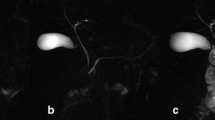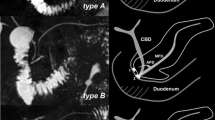Abstract
The aim of this study was to quantify pancreatic exocrine function in normal subjects and in patients with chronic pancreatitis (CP) before and after pancreatic duct drainage procedures (PDDP) with dynamic secretin-enhanced magnetic resonance (MR) cholangiopancreatography (S-MRCP). Pancreatic exocrine secretions [quantified by pancreatic flow output (PFO) and total excreted volume (TEV)] were quantified twice in ten healthy volunteers and before and after treatment in 20 CP patients (18 classified as severe, one as moderate, and one as mild according to the Cambridge classification). PFO and TEV were derived from a linear regression between MR-calculated volumes and time. In all subjects, pancreatic exocrine fluid volume initially increased linearly with time during secretin stimulation. In controls, the mean PFO and TEV were 6.8 ml/min and 97 ml; intra-individual deviations were 0.8 ml/min and 16 ml. In 10/20 patients with impaired exocrine secretions before treatment, a significant increase of PFO and TEV was observed after treatment (P<0.05); 3/20 patients presented post-procedural acute pancreatitis and a reduced PFO. The S-MRCP quantification method used in the present study is reproducible and provides normal values for PFO and TEV in the range of those obtained from previous published intubation studies. The initial results in CP patients have demonstrated non-invasively a significant short-term improvement of PFO and TEV after PDDP.





Similar content being viewed by others
References
Etemad B, Whitcomb DC (2001) Chronic pancreatitis: diagnosis, classification and new genetic developments. Gastroenterology 120:682–707
Karanjia ND, Singh SM, Widdison AL, Lutrin FS, Reber HA (1992) Pancreatic duct and interstitial pressures in cats with chronic pancreatitis. Dig Dis Sci 37:268–273
Glasbrenner B, Kahl S, Malfertheiner P (2002) Modern diagnostics of chronic pancreatitis. Eur J Gastroenterol Hepatol 14:935–941
Delhaye M, Matos C, Devière J (2003) Endoscopic management of chronic pancreatitis. Gastrointest Endoscopy Clin N Am 13:717–742
Rosch T, Daniel S, Scholz M, Huibregtse K, Smits M, Schneider T, Ell C, Haber G, Riemann JF, Jacobs R, Hintze R, Adler A, Neuhau H, Zavoral M, Zavada F, Schusdziarra V, Soehendra N (2002) Endoscopic treatment of chronic pancreatitis: a multicenter study of 1000 patients with long-term follow-up. Endoscopy 34:765–771
Laugier R (1994) Dynamic endoscopic manometry of the response to secretin in patients with chronic pancreatitis. Endoscopy 26:222–227
Delhaye M, Vandermeeren A, Baize M, Cremer M (1992) Extracorporeal shock-wave lithotripsy of pancreatic calculi. Gastroenterology 102:610–620
Deviere J, Urbain P, Cremer M (1987) Reversibility of exocrine pancreatic function. Gastroenterology 92:2053–2054
Malfertheiner P, Büchler M (1989) Correlation of imaging and function in chronic pancreatitis. Radiol Clin North Am 27:51–64
Robberecht P, Cremer M, Vandermeers A, Vandermeers-Piret MC, Cotton P, De Neef P, Cristophe J (1975) Pancreatic secretion of total protein and of three hydrolases collected in healthy subjects via duodenoscopic cannulation. Gastroenterology 69:374–379
Matos C, Metens T, Devière J, Nicaise N, Braude P, Van Yperen G, Cremer M, Struyven J (1997) Pancreatic duct: morphologic and functional evaluation with dynamic MR pancreatography after secretin stimulation. Radiology 203:435–441
Cappeliez O, Delhaye M, Devière J, Lemoine O, Metens T, Nicaise N, Cremer M, Struyven J, Matos C (2000) Chronic pancreatitis: evaluation of pancreatic exocrine function with MR pancreatography after secretin stimulation. Radiology 215:358–364
Sica GT, Braver J, Cooney MJ, Miller FH, Chai JL, Adams DF (1999) Comparison of endoscopic retrograde cholangiopancreatography with MR cholangiopancreatography in patients with pancreatitis. Radiology 210:605–610
Manfredi R, Costamagna G, Brizi MG, Maresca V, Vecchioli A, Colagrande C, Marano P (2000) Severe chronic pancreatitis versus suspected pancreatic disease: dynamic MR cholangiopancreatography after secretin stimulation. Radiology 214:849–855
Heverhagen JT, Muller D, Battmann A, Ishaque N, Boehm D, Katschinski M, Wagner HJ, Klose KJ (2001) MR hydrometry to assess exocrine function of the pancreas: initial results of noninvasive quantification of secretion. Radiology 218:61–67
Punwani S, Gillams AR, Lees WR (2003) Non-invasive quantification of pancreatic exocrine function using secretin-stimulated MRCP. Eur Radiol 13:273–276
Heverhagen JT, Battmann A, Kirsch M, Boehm D, Eissele R, Klose KJ, Wagner HJ (2002) Magnetic resonance hydrometry: non-invasive quantification of the exocrine pancreatic function. Fortschr Röntgenstr 174:291–296
Axon AT, Classen M, Cotton PB, Cremer M, Freeny PC, Lees WR (1984) Pancreatography in chronic pancreatitis: international definitions. Gut 25:1107–1112
Ammann RW, Muellhaupt B (1999) The natural history of pain in chronic pancreatitis. Gastroenterology 116:1132–1140
Pruessmann KP, Weiger M, Scheidegger MB, Boesiger P (1999) SENSE: sensitivity encoding for fast MRI. Magn Reson Med 42:952–962
Bland JM, Altman DG (1986) Statistical methods for assessing agreement between two methods of clinical measurement. Lancet 1:307–310
Arvanitakis M, Delhaye M, De Maertelaere V, Bali M, Winant C, Coppens E, Jeanmart J, Zalcman M, Van Gansbeke D, Devière J, Matos C (2004) Computed tomography and magnetic resonance imaging in the assessment of acute pancreatitis. Gastroenterology 126:715–723
Devière J, Gulbis B, Delhaye M, Quenon M, Cremer M (1985) Relation entre la morphologie canalaire et la fonction exocrine du pancréas: une méthode originale d’estimation linéaire de la fonction pancréatique. Acta Endoscopica 15:403–414
Bozkurt T, Braun U, Leferink S, Gilly G, Lux G (1984) Comparison of pancreatic morphology and exocrine functional impairment in patients with chronic pancreatitis. Gut 35:1132–1136
Andrén-Sandberg A, Hoem D, Gislason H (2002) Pain management in chronic pancreatitis. Eur J Gastroenterol Hepatol 14:957–970
Ohara H, Hoshino M, Hayakawa T, Kamiya Y, Miyaji M, Takeuchi T, Okayama Y (1996) Single application of extracorporeal shock wave lithotripsy is the first choice for patients with pancreatic stones. Am J Gastroenterol 91:1388–1392
Delhaye M, Arvanitakis M, Verset G, Cremer M, Devière J (2004) Long-term clinical outcome after endoscopic pancreatic ductal drainage for patients with painful chronic pancreatitis. Clinical Gastroenterol Hepatol 2:1096–1106
O’Keefe SDJ, Byrd-Lee R, Abou-Assi S (2002) Acute pancreatitis reduces pancreatic enzyme secretion but not synthesis in human. Gut 51(Suppl III):A62
Niederau C, Niederau M, Lüthen R, Strohmeyer G, Ferrell LD, Grendell JH (1990) Pancreatic exocrine secretion in acute experimental pancreatitis. Gastroenterology 99:1120–1127
Author information
Authors and Affiliations
Corresponding author
Rights and permissions
About this article
Cite this article
Bali, M.A., Sztantics, A., Metens, T. et al. Quantification of pancreatic exocrine function with secretin-enhanced magnetic resonance cholangiopancreatography: normal values and short-term effects of pancreatic duct drainage procedures in chronic pancreatitis. Initial results. Eur Radiol 15, 2110–2121 (2005). https://doi.org/10.1007/s00330-005-2819-5
Received:
Revised:
Accepted:
Published:
Issue Date:
DOI: https://doi.org/10.1007/s00330-005-2819-5




